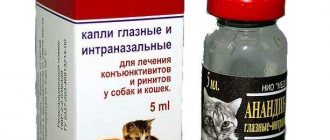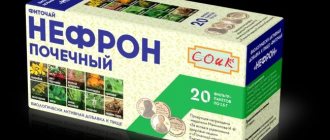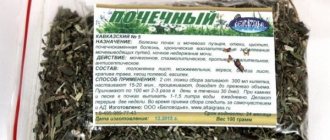Write a review
Reviews: 0
Manufacturers: Valenta Pharmaceuticals
Active ingredients
- Chlorpromazine
Disease class
- Mental and behavioral disorders caused by alcohol use - withdrawal symptoms with delirium
- Mental and behavioral disorders caused by alcohol use - psychotic disorder
- Phobic anxiety disorders
- Disturbances in falling asleep and maintaining sleep [insomnia]
- Meniere's disease
- Dermatitis, unspecified
- Excessive vomiting during pregnancy
- Anxiety and agitation
Clinical and pharmacological group
- Not indicated. See instructions
Pharmacological action
- Neuroleptic
- Antiemetic
- Hypotensive
- Antihistamine
Pharmacological group
- Neuroleptics
Solution for intravenous and intramuscular administration Aminazine (Aminazine)
Instructions for medical use of the drug
Description of pharmacological action
Aminazine is one of the main representatives of neuroleptics (medicines that have an inhibitory effect on the central nervous system and do not cause a hypnotic effect in normal doses). Despite the emergence of numerous new antipsychotic drugs, it continues to be widely used in medical practice. One of the main features of the action of aminazine on the central nervous system is its relatively strong sedative effect (calming effect on the central nervous system).
Indications for use
In psychiatric practice, aminazine is used in various states of psychomotor agitation in patients with schizophrenia (hallucinatory-delusional, hebephrenic, catatonic syndromes), in chronic paranoid and hallucinatory-paronoid states, manic agitation in patients with manic-depressive psychosis (psychosis with alternating excitement and depression of mood) , with psychotic disorders in patients with epilepsy, with agitated depression (motor excitation against a background of anxiety and fear) in patients with presenile (stressful), manic-depressive psychosis, as well as with other mental illnesses and neuroses accompanied by agitation, fear, insomnia, tension, in acute alcoholic psychosis. Aminazine can be used either alone or in combination with other psychotropic drugs (antidepressants, butyrophenone derivatives, etc.). A peculiarity of the action of aminazine in states of excitement in comparison with other antipsychotics (triftazine, haloperidol, etc.) is a pronounced sedative (calming) effect. In neurological practice, aminazine is also prescribed for diseases accompanied by increased muscle tone (after a cerebral stroke, etc.). Sometimes used to relieve status epilepticus (if other treatment methods are ineffective). It is administered intravenously or intramuscularly for this purpose. It should be borne in mind that in patients with epilepsy, chlorpromazine can cause an increase in seizures, but usually when prescribed simultaneously with anticonvulsants, it enhances the effect of the latter. The use of aminazine in combination with analgesics for persistent pain, including causalgia (intense burning pain due to damage to a peripheral nerve), and with sleeping pills and tranquilizers (sedatives) for persistent insomnia is effective. Aminazine is sometimes used as an antiemetic agent for vomiting of pregnant women, Meniere's disease (a disease of the inner ear), in oncological practice - in the treatment of bis-(beta-chloroethyl)amine derivatives and other chemotherapeutic drugs, and during radiation therapy. In the clinic of skin diseases for itchy dermatoses (skin diseases) and other diseases.
Release form
solution for intravenous and intramuscular administration 2.5%; 1 ml ampoule with ampoule knife, cardboard pack 5.10. solution for intravenous and intramuscular administration 2.5%; ampoule 2 ml with ampoule knife, cardboard pack 5.10. solution for intravenous and intramuscular administration 2.5%; ampoule 1 or 5 ml, contour cell packaging 5. solution for intravenous and intramuscular administration 2.5%; ampoule 5 ml, cardboard pack 10. solution for intravenous and intramuscular administration 25 mg/ml; 1 ml ampoule with ampoule knife, cardboard pack 10. solution for intravenous and intramuscular administration 25 mg/ml; ampoule 10 ml with ampoule knife, cardboard pack 10. solution for intravenous and intramuscular administration 25 mg/ml; ampoule 2 ml with ampoule knife, cardboard pack 10. solution for intravenous and intramuscular administration 25 mg/ml; ampoule 5 ml with ampoule knife, cardboard pack 10. solution for intravenous and intramuscular administration 25 mg/ml; ampoule 10 ml with ampoule knife, contour plastic packaging (pallets) 5, cardboard pack 1. solution for intravenous and intramuscular administration 25 mg/ml; 1 ml ampoule with ampoule knife, contour plastic packaging (pallets) 5, cardboard pack 2. solution for intravenous and intramuscular administration 25 mg/ml; ampoule 2 ml with ampoule knife, contour plastic packaging (pallets) 5, cardboard pack 2. solution for intravenous and intramuscular administration 25 mg/ml; 5 ml ampoule with ampoule knife, contour plastic packaging (pallets) 5, cardboard pack 2.
Pharmacodynamics
Antipsychotic drug (neuroleptic) from the group of phenothiazine derivatives. It has a pronounced antipsychotic, sedative, antiemetic effect. Reduces or completely eliminates delusions and hallucinations, stops psychomotor agitation, reduces affective reactions, anxiety, restlessness, and reduces motor activity. The mechanism of antipsychotic action is associated with blockade of postsynaptic dopaminergic receptors in the mesolimbic structures of the brain. It also has a blocking effect on α-adrenergic receptors and suppresses the release of pituitary and hypothalamic hormones. However, blockade of dopamine receptors increases the secretion of prolactin by the pituitary gland. The central antiemetic effect is due to inhibition or blockade of dopamine D2 receptors in the chemoreceptor trigger zone of the cerebellum, the peripheral effect is due to blockade of the vagus nerve in the gastrointestinal tract. The antiemetic effect is enhanced, apparently, due to anticholinergic, sedative and antihistamine properties. The sedative effect is apparently due to alpha-adrenergic blocking activity. Has moderate or weak extrapyramidal effects.
Pharmacokinetics
When taken orally, chlorpromazine is rapidly, but sometimes not completely, absorbed from the gastrointestinal tract. Cmax in blood plasma is reached after 2-4 hours. It is subject to the “first pass” effect through the liver. Due to this effect, plasma concentrations after oral administration are less than concentrations after intramuscular administration. Intensively metabolized in the liver with the formation of a number of active and inactive metabolites. The metabolic pathways of chlorpromazine include hydroxylation, conjugation with glucuronic acid, N-oxidation, oxidation of sulfur atoms, dealkylation. Chlorpromazine has high binding to plasma proteins (95-98%). It is widely distributed in the body, penetrates the BBB, and the concentration in the brain is higher than in plasma. There was marked variability in pharmacokinetic parameters in the same patient. There is no direct correlation between plasma concentrations of chlorpromazine and its metabolites and the therapeutic effect. T1/2 of chlorpromazine is about 30 hours; It is believed that the elimination of its metabolites may take longer. Excreted in urine and bile in the form of metabolites.
Use during pregnancy
If it is necessary to use chlorpromazine during pregnancy, the duration of treatment should be limited, and at the end of pregnancy, if possible, the dose should be reduced. It should be borne in mind that chlorpromazine prolongs labor. If use is necessary during lactation, breastfeeding should be discontinued. Chlorpromazine and its metabolites penetrate the placental barrier and are excreted in breast milk. Clinical studies have shown that chlorpromazine may have a teratogenic effect. When chlorpromazine was used in high doses during pregnancy in newborns, in some cases, digestive disorders associated with atropine-like effects and extrapyramidal syndrome were observed.
Contraindications for use
Impaired function of the liver, kidneys, hematopoietic organs, progressive systemic diseases of the brain and spinal cord, myxedema, severe cardiovascular diseases, thromboembolic disease; late stage of bronchiectasis; angle-closure glaucoma; urinary retention associated with prostatic hyperplasia; severe depression of the central nervous system, coma, brain injury.
Side effects
From the side of the central nervous system: possible akathisia, blurred vision; rarely - dystonic extrapyramidal reactions, parkinsonian syndrome, tardive dyskinesia, thermoregulation disorders, NMS; in isolated cases - convulsions. From the cardiovascular system: possible arterial hypotension (especially with intravenous administration), tachycardia. From the digestive system: dyspeptic symptoms are possible (when taken orally); rarely - cholestatic jaundice. From the hematopoietic system: rarely - leukopenia, agranulocytosis. From the urinary system: rarely - difficulty urinating. From the endocrine system: menstrual irregularities, impotence, gynecomastia, weight gain. Allergic reactions: possible skin rash, itching; rarely - exfoliative dermatitis, erythema multiforme. Dermatological reactions: rarely - skin pigmentation, photosensitivity. On the part of the organ of vision: with long-term use in high doses, chlorpromazine may be deposited in the anterior structures of the eye (cornea and lens), which can accelerate the processes of normal aging of the lens.
Directions for use and doses
IM or IV, the highest single dose for IM administration is 0.15 g, daily dose is 0.6 g. Typically, 1–5 ml of a 2.5% solution is administered IM no more than 3 times a day. In case of acute mental agitation, IV - 2-3 ml of a 2.5% solution in 20 ml of a 40% glucose solution. The highest single dose for intravenous administration is 0.1 g, daily dose is 0.25 g.
Special instructions for use
Phenothiazines are used with extreme caution in patients with pathological changes in the blood picture, liver dysfunction, alcohol intoxication, Reye's syndrome, as well as breast cancer, cardiovascular diseases, predisposition to the development of glaucoma, Parkinson's disease, gastric and duodenal ulcers , urinary retention, chronic respiratory diseases (especially in children), epileptic seizures. Phenothiazines should be used with caution in elderly patients (increased risk of excessive sedation and hypotensive effects), in debilitated and weakened patients. If hyperthermia occurs, which is one of the symptoms of NMS, chlorpromazine should be discontinued immediately. Children, especially those with acute illness, are more likely to develop extrapyramidal symptoms when using phenothiazines. During the treatment period, avoid drinking alcohol. Effect on the ability to drive vehicles and operate machinery Should be used with caution in patients engaged in potentially hazardous activities that require a high speed of psychomotor reactions.
Storage conditions
In a place protected from light, at a temperature of 15–25 °C.
Best before date
24 months
ATX classification:
N Nervous system
N05 Psycholeptics
N05A Antipsychotic drugs
N05AA Phenothiazine derivatives with aliphatic structure
N05AA01 Chlorpromazine
Aminazine recipe in Latin
Rp.: Sol. Chiorpromazini 2.5% - 2.0 Dtd No. 10 in amp. S. 2.0 intramuscularly 2 times a day. Rp.: Tab. Chiorpromazini 0.05 Dtd No. 50 S. 1 tablet 3 times a day.
The main difference between chlorpromazine and other antipsychotics is its strong and quickly onset sedative (calming) effect. Therefore, in practice, it is widely used only as an “ambulance” remedy for psychosis, nervous breakdowns, aggression, etc.
Due to its side effects, it is used extremely rarely for permanent or long-term use (only in cases where other means are not effective).
Like any medicine, aminazine should be used only after examination by a doctor and determination of indications and contraindications.
Similar drugs:
- Ergoferon () Lozenges
- Celandine grass (Chelidonii majoris herba) Vegetable raw materials
- L-cet Oral tablets
- Loratadine Syrup
- Peritol Oral tablets
- Loratadine-Teva Oral tablets
- Erespal Oral tablets
- Levocetirizine-Teva Oral tablets
- Aminazine Dragee
- Lordestin Oral tablets
** The Drug Directory is intended for informational purposes only. For more complete information, please refer to the manufacturer's instructions. Do not self-medicate; Before starting to use the drug Aminazine, you should consult a doctor. EUROLAB is not responsible for the consequences caused by the use of information posted on the portal. Any information on the site does not replace medical advice and cannot serve as a guarantee of the positive effect of the drug.
Are you interested in the drug Aminazine? Do you want to know more detailed information or do you need a doctor's examination? Or do you need an inspection? You can make an appointment with a doctor - the Euro lab is always at your service! The best doctors will examine you, advise you, provide the necessary assistance and make a diagnosis. You can also call a doctor at home . Euro lab clinic is open for you around the clock.
** Attention! The information presented in this medication guide is intended for medical professionals and should not be used as a basis for self-medication. The description of the drug Aminazine is provided for informational purposes and is not intended for prescribing treatment without the participation of a doctor. Patients need to consult a specialist!
If you are interested in any other drugs and medications, their descriptions and instructions for use, information about the composition and form of release, indications for use and side effects, methods of use, prices and reviews of drugs, or you have any other questions and suggestions - write to us, we will definitely try to help you.


